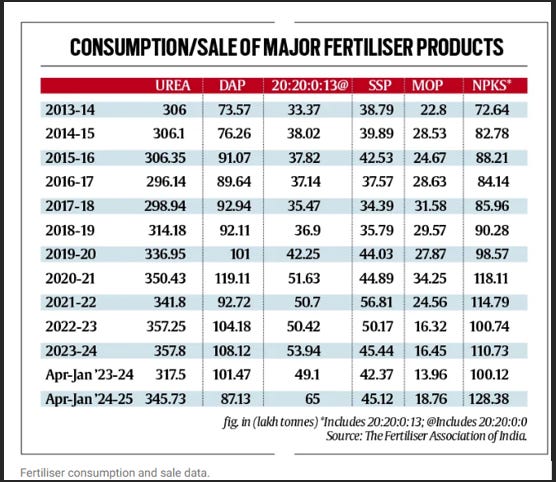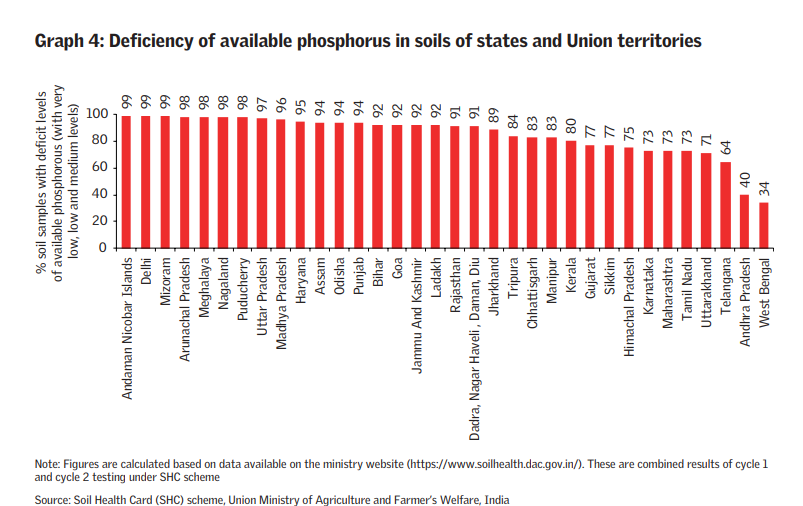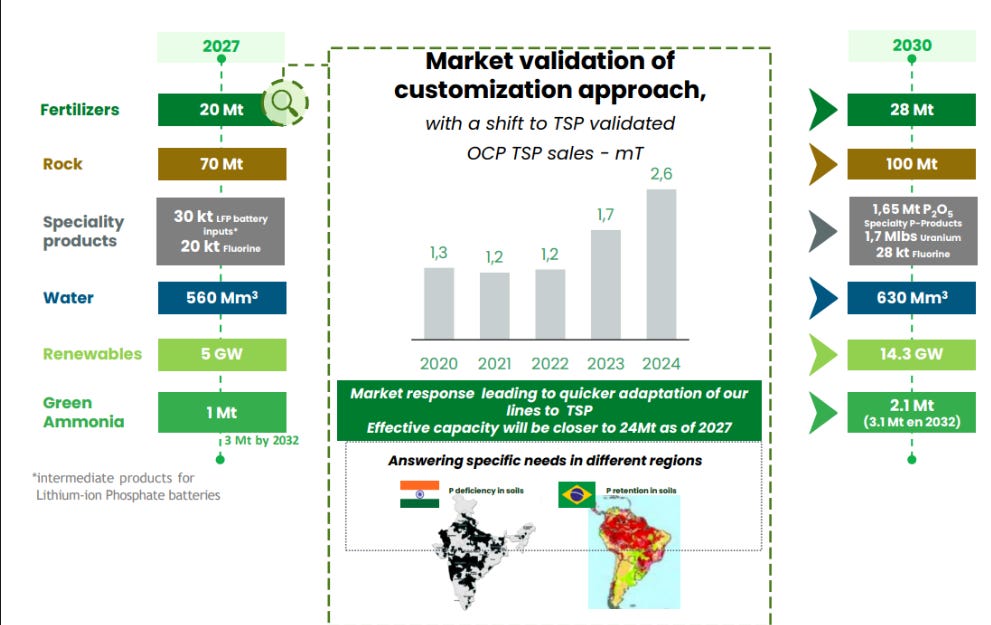Reimagining Phosphorus: OCP Nutricrops and the Triple Super Promise
Can Triple Super Phosphate unlock sustainable futures for Phosphorus that serve the plant and planet Earth?
Agribusiness Matters is read by 45811 readers across Substack and LinkedIn who are curious to get to the bottom of food and agriculture systems in an age of runaway Climate Change.
Dear Friends,
Today marks a special day in the annals of Agribusiness Matters. I am doing a sponsored deep-dive with OCP Nutricrops that has been at the center of this wicked question lock, stock and barrel.
After my last sponsored deep dive with Bioprime, I kept postponing sponsored deep dives for obvious reasons. I couldn’t find the right player who would walk along through an ethical minefield in sincere pursuit of a wicked question that defies easy answers.
OCP Nutricrops, a subsidiary of OCP Group, is, as their website states, “the custodian of 70% of the world’s known phosphate reserves”. When I first started, I had my apprehensions. However, as I started chatting with different teams inside OCP Nutricrops, I was happy to see openness to listening to diverse perspectives that go beyond the safe and sterilized narratives that typically get official sanctions.
Perhaps, there is a merit in Voltaire’s memorable words: With great Power Comes Great Responsibility. That said, here is an important disclaimer: These are my viewpoints as an agritech analyst who looked at OCP’s TSP strategy closely. This shouldn’t be read or interpreted in anyway as OCP’s official stance.
Since I deeply value the trust you repose in me as a reader and subscriber, it is my duty to explain how I approached this process without compromising my ethics as an agritech analyst. You can learn here about how I select the companies to work with and my responses to the sponsored deep-dive ethics checklist, besides OCP Nutricrops’s responses. If you have any questions on my approach and would like to offer feedback, you are most welcome to email me (venkyr@hey.com) or share here anonymously.
Shall we begin?
Reimagining Phosphorus: OCP Nutricrops and the Triple Super Promise
Deep gratitude to Supal Sharma, Sanjay Naithani, Bob Morris, Dr. Santosh Talegaonkar, Ajay Bhartiya and other friends from the fertilizer industry for many insightful conversations that helped me think through this. Special thanks to Santosh and Bob for their insightful comments on the early drafts of this essay.
This long essay can be read in one sitting if you are from Mars and can read without distractions within 12- 13 minutes. If you are short on time, you can jump directly to sections that are important to you.
A Story of Two Paradigms – Can an ancient parable on the life of Alexander throw light on the two paradigms that define our relationship with the soil? Can Triple Super Phosphate (TSP) help OCP Nutricrops transcend the current paradigm that underpins our relationship with the soil? What about India?
Indian Fertilizer Industry: Red Queen’s Dilemma - Can TSP address the inherent structural challenges in the Indian Fertilizer Industry? What about Phosphorus Paradox?
Addressing the Phosphorus Paradox - How do we deal with the excess phosphorus locked without a way for plants to access them for their growth? What are the local and global ramifications of Phosphorus Paradox? What about the future?
Speculative Futures of Phosphorus - What are some of the speculative futures that await us in managing the sustainable futures of Phosphorus?
A Story of Two Paradigms
Legend goes that Alexander once met an Indian Monk (Gymnosophist, as the Greeks called them) while traveling towards the Indian subcontinent.
"What are you doing?" asked Alexander.
"Doing Nothing".
"What are you doing?", asked the monk.
"Conquering the World"
Both smirked at each other, each dismissing each other's stupidity.
This old parable showcasing the conflict between action and understanding (documented by Plutarch in Life of Alexander) mirrors a fundamental divide in Modern Agriculture.
When I look at the two paradigms that underpin our collective relationship with soil, I am often reminded of this story.
The Gymnosophist Paradigm, embodied in Masanobu Fukuoka’s ‘Do Nothing Farming’, sees the soil as an alive, teeming microbiome where bacteria and fungi broker nutrients in complex, mutualist networks.
The Alexandrian Paradigm, embodied in Industrial Agriculture’s eternal battle against hunger, sees the soil as substrate, the plant as central hub, and every nutrient deficiency as a supply chain problem to be solved.
Agriculture, as it stands today, sits between these two paradigms with each coveting the other for its strengths and hating the other for its weakness. Anxious in its quest to dominate, the Alexandrian paradigm has now resorted to pooking behaviours, tigers' tested hunting strategy of mimicking the alarm call of their prey. How do you discredit your opposing paradigm opponent? Coopt their sounds and hunt them down.
Take the rampant use of industry category labels such as "regenerative" or "climate-smart agriculture" or "sustainable agriculture" for product portfolio comprising both synthetic pesticides, biological products, besides a vast array of spurious products available in the informal markets with a deadly combination of both. When there is massive greenwashing in biological agri-inputs, I start to wonder if these category labels are games of narrative propaganda to discredit the opposing paradigm.
For a very long time, the Fertilizer industry has been attempting to leapfrog its paradigm from the Alexandrian to the Gymnosophist view, moving from the traditional commodity fertilizer approach towards customized fertilization.
A key player in this ongoing evolution is OCP Nutricrops, which has skillfully navigated the changing landscape of the phosphate fertilizer industry.
OCP Nutricrops has walked along every stage of evolution in the phosphate fertilizer industry, starting from the early Rock Phosphate days to its current TSP-led approach which rides on customization (based on 4 R) and precision agriculture solutions to hack phosphates.
For OCP Nutricrops, TSP is more than a fertilizer. It is the vector of customization that provides farmers with customized fertilization solutions, enhanced with phosphorus solubilizing bacteria and essential secondary and micro-nutrients (Sulfur, Zinc, Boron) that could provide efficient nutrient management and optimal plant growth.
And so the central question I am exploring in this sponsored deep dive is the following:
Can TSP, which traditionally comes from the Alexandrian paradigm, adapt itself to the Gymnosophist paradigm which encourages circular phosphorus economy, cycling through plants, animals and soil in a closed loop on a farm that recycles its biomass and waste?
Currently, Triple Super Phosphate, a phosphorus-rich fertilizer that contains no nitrogen, is considered a low-carbon and sustainable fertilization solution.1
OCP Nutricrops has invested approximately $13 Bn to use 100% non-conventional water and 100% clean energy, targeting 630 million cubic meters of water and 14.3 GW of renewables by 2032. In its run up to 2030, OCP Nutricrops plans to scale up to 28 Mt of fertilizers, 100 Mt of phosphate rock, 1.65 Mt of phosphoric acid (P₂O₅) in specialty P-products and 2.1 Mt of green ammonia.
India could be a fascinating test ground to test this TSP-led vector approach rooted in sustainability, provided farmers are adequately trained through initiatives such as Project ACE. The latter aims to provide skilling and capacity building for farmers on the principles of nutrient management, water management and financial literacy. The question remains: Would it work? How would it add up?
Indian Fertilizer Industry: Red Queen’s Dilemma
India’s Fertilizer Industry has been stuck with decades-old formula of 4:2:12, leading to excess use of Nitrogen and deficit of P and K. More than 50% of India’s fertilizer use is nitrogen-based. DAP (which contains both nitrogen and phosphorus) receives higher subsidies than TSP, skewing adoption, even when agronomy would suggest otherwise.
India’s fertilizer ecosystem is trapped in a Red Queen’s dilemma: It keeps running to remain in the same place. Technological upgrades like neem-coated urea, nano urea, and Potash Derived from Molasses (PDM) promise hope, but structural imbalances persist. Fertilizer use continues to be nitrogen-heavy, and policy reforms remain stuck in loops that go nowhere.
Between 2000 and 2021, complex fertilizer use grew by 163%, DAP by 103%, and urea by 83%.3 Ammonium Phosphate Sulphate became the third largest-consumed fertilizer after Urea and DAP, overtaking SSP which had grown by 25% between 2000-01 and 2018-19. Soil health degradation, raw material dependency, and energy costs have all intensified.

Chinese restrictions on DAP and MAP exports, combined with increasing Chinese domestic consumption, have opened a short-term window for TSP adoption in markets like India. This is pretty similar to what happened in markets like Brazil where tightness of phosphate markets, driven by the absence of Chinese DAP and MAP, led buyers to move towards TSP.
OCP Nutricrops introduced TSP for the Indian Market in Q2 2024 through its partners. Can TSP-led product approach address some of these structural challenges in the Indian Fertilizer sector?
It is one thing to talk about nutrient separate management (separating nitrogen and phosphorus) and 4R (Right Source, Right Rate, Right Time, Right Place) in the judicial use of phosphorus fertilizers. How do we implement them within the context of Indian market policies?
TSP’s entry, if strategized right, could be more than a product launch.
It could help India address the Red Queen Dilemma logjam. It could be an experiment to deliver nutrient precision based on soil health card data available across India’s 790 districts. More importantly, it could validate if soil-health, ecological balance and economic efficiency collectively remain a win-win proposition for India’s farmers.
To tackle this ambitious question, it is important to address the elephant in the room. Phosphorus Paradox. What is Phosphorus Paradox? Can TSP address the Phosphorus Paradox?
Addressing the Phosphorus Paradox
Much like in the case of phosphate fertilizers, TSP is water-soluble and provides a flush of available phosphate, but crops typically absorb only a small fraction of what is applied. In fact, crops seldom take up more than about 15–25% of fertilizer P in the first season.
This is at the heart of the Phosphorus Paradox that besets us. It has global and local ramifications.
While the Global North suffers from phosphorus overuse, leading to eutrophication and environmental degradation, the Global South faces widespread phosphorus deficiency.
In India, the overapplication of nitrogen, particularly in irrigated cereal cropping systems, has significantly contributed to eutrophication and elevated nitrate leaching. Meanwhile, soils across much of India are alkaline (pH > 7), leading to phosphorus fixation by calcium carbonate, thereby reducing its plant availability. This constraint is further aggravated by cereal-dominated cropping systems which amplify the nutrient imbalance, especially widening the N:P ratio in soil-plant systems.
CSE’s State of Biofertilizer Report spells out the ground truth. In nineteen states and Union Territories, over 90% of soil samples show low phosphorus levels. The carbon content in Indian soil has reached dangerously low levels, often just 0.3% or lower. The diminished carbon has led to poor absorption of chemical nutrients due to diminishing microbial populations.

Although 10-15% of applied phosphorus is typically taken up by the plant, 80-90% become immobilized in the rhizosphere, primarily in forms that are unavailable for immediate uptake. Since phosphorus is predominantly applied as a basal dose, its limited mobility severely restricts its accessibility. Even when phosphorus is abundant, a separation of just a few centimeters from the root zone can render it inaccessible.
Timing also matters as microbial activity in the soil fluctuates with environmental and cropping conditions. Soil testing conducted during periods of low-microbial activity may lead to inaccurate assessments and over-fertilization.4
Addressing the Phosphorus Paradox requires close coordination among soil scientists, microbiologists and agronomists. Conventional N & P trials are often conducted on biologically inactive soils which do not accurately reflect real-world plant-microbe-soil interactions.
A promising solution lies in microbial alliances, particularly with Phosphate-solubilizing bacteria (PSB) and customized nutrient formulations viz., TSP enriched with PSB, high-P blends with nitrogen starters and targeted micronutrients.
During my interactions with the OCP Nutricrops Agronomy team, I was introduced to early-stage trials that combine Triple Super Phosphate with Phosphate solubilizing bacteria. These trials, conducted in collaboration with leading research institutes and local implementation partners span five key agro-climatic zones: Delhi, Junagadh (Gujarat), Dharwad (Karnataka), Indore (Madhya Pradesh), and Samastipur (Bihar).
Preliminary findings suggest strong potential to enhance crop productivity, especially for pulses and oilseeds that can contribute to improved agricultural self-reliance. The use of phosphate solubilizing bacteria, which unlocks fixed phosphorus in the soil, could prove to be highly effective, provided the economic viability of such biological integrations is thoroughly evaluated before large-scale deployment.
Solving Phosphorus Paradox requires Precision agriculture that localizes the 4R: Right Source, Right Rate, Right Time, Right Place. Among the retailer community, TSP is considered as a good substitute for DAP for basal dose. It is also considered a very good fertilizer for Rabi crops such as Wheat, Potato and Mustard.
OCP Nutricrops’s partnership with platforms like Krishi-RASTAA (courtesy Krishitantra) is a good start in unlocking agronomic efficiencies through precise formulations and regional targeting at local District, Block and Taluka levels. These could bring precise and targeted matching of fertilizers to the edaphic properties of regional soils (acidic vs alkaline soils) and crops.
By matching regional soil pH (available through Soil Health Card database) and crop patterns with fertilizer recommendations, it can lay the groundwork for precision agriculture at scale.
Through block/district centric Digital Public Infrastructures (experiments underway through Open Agrinet in Uttar Pradesh and Unified Krishi Interface in Nashik), these efforts could be scaled across India’s 790 districts.
Indian Fertilizer Market circa 2025 is currently where China was during the year 1999.
1999 remains a watershed year for China as it led to the reform of the fertilizer distribution systems. China abolished its mandatory procurement plan for fertilizers, allowing market allocation and private innovation. The result was a rapid shift toward region- and crop-specific compound fertilizers.
India, in contrast, remains bound to price control and freight subsidies. The Soil Health Card scheme has created valuable data, but localized implementation remains weak. Can India now move toward adaptive, market-driven models without abandoning the safety nets farmers rely on?
Can India adapt China’s policy-driven approach to suit India’s diverse agro-climatic conditions? Can Indian policymakers establish region-specific strategies based on soil pH levels that encourage efficient fertilizer use while maintaining soil fertility?
In May 2025, the Ministry of Agriculture issued a special notification bringing bio stimulants (seaweed extracts, fulvic acids) under the Fertilizer Control Order. Though first recognized in 2021, this move signals deeper regulatory support for biologically active soil interventions, albeit a top-down approach derived from the fertilizer paradigm is unsuited for biologicals.
Recycling phosphorus through organic residues and municipal waste is another promising path that remains an exciting untapped opportunity for OCP Nutricrops. Crystalline struvite, a high-value recycled phosphorus product, has proven cost-effective in early trials5. Yet, India lacks a strong regulatory or financial framework to support circular nutrient economies.
Speculative Futures of Phosphorus
By 2040, we may see synthetic biology enable phosphorus-solubilizing microbes. AI-guided nutrient application could slash fertilizer overuse provided we have scaled Agri-stack initiatives through Digital Public Infrastructure. High-value recycled phosphorus fertilizers might become cost-competitive with mined phosphate. Sustainability-linked phosphorus credits—analogous to carbon markets—could emerge.
Could phosphorus use be included in ESG frameworks? Could India lead in creating a phosphorus stewardship fund, modeled on REDD+ for forests?
OCP Nutricrops, through its partnerships with UM6P and InnovX, is exploring these frontiers. Their nutrient separation and microbial integration models are at early-stages, but if scaled via India’s DPI networks, have strong potential to change the market landscape.
The future of Phosphorus is too important to make it a reductive battle between the Alexandrian and Gymnosophist paradigms. It’s about synthesis.
Can we engineer for efficiency while respecting ecological complexity? Can we redesign subsidies to reward not just volume, but mass nutrient balance across districts based on their soil profiles?
Can we build soil-intelligent precision agriculture systems that respect the soil-microbes, slowly moving away from a ‘broadcast fertilizer’ approach to a ‘biological foraging’ approach?
Can OCP’s Phosphorus Futures build long-term fungal networks that help funnel phosphorus directly to plants, avoiding waste or runoff?
Can we learn to dialogue better with soil, microbes, science and systems?
Let’s hope:)
So, what do you think?
How happy are you with today’s edition? I would love to get your candid feedback. Your feedback will be anonymous. Two questions. 1 Minute. Thanks.🙏
💗 If you like “Agribusiness Matters”, please click on Like at the bottom and share it with your friend.
TSP is not covered by the EU’s Carbon Border Adjustment Mechanism (CBAM) and is exempt from carbon tariffs in Europe. The European Union’s Carbon Border Adjustment Mechanism (CBAM) is designed to ensure imported carbon-intensive products reflect their true environmental cost, while also promoting cleaner manufacturing practices in countries outside the EU. You can learn more about CBAM here.
For More details, “Fertilizer Use and Imbalance in India”, EPW Article by Ramesh Chand and Pavithra S.
Data from State of Biofertilizers and Organic Fertilizers in India 2022 , CSE Publication.
I discovered this insight from the wondrous Dr. Christine Jones’ Presentation on Phosphorus Paradox.
A 2025 techno-economic assessment of phosphorus recovery as struvite from swine wastewater found that the process achieved over 80% phosphate recovery efficiency, with a unit production cost of $6.56 per kg of phosphorus and a payback period as short as 3.91 years for small-scale farms. The study concluded that the struvite production system is "moderate and competitive" in cost compared to other chemical precipitation processes and offers practical benefits for sustainable phosphorus management and the circular economy. You can learn more about the study here.







